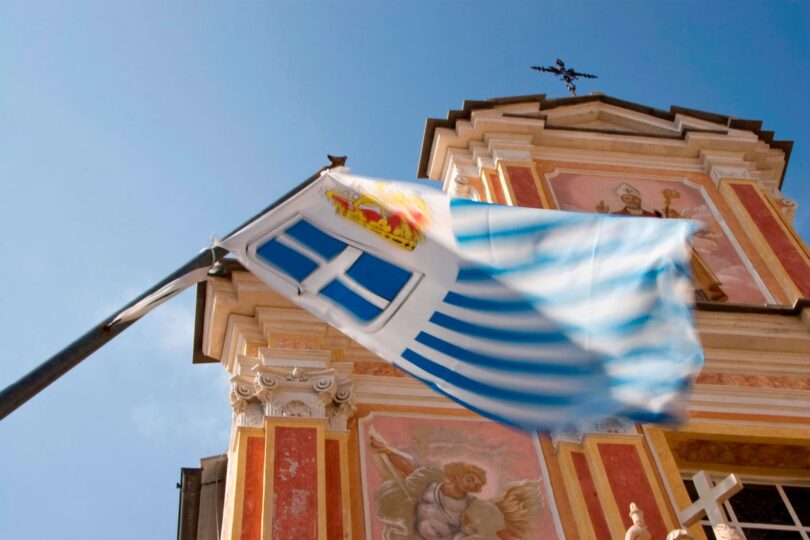The Seborga flag flying in the Piazza San Martino. (Photo by Caterina Bruzzone/REDA&CO/Universal … [+]
Italy may be best known for its epochal cities and dazzling seaside havens, but the country’s hilltop towns and borghi—medieval throwbacks found from the Alpine north to Sicily—also draw throngs of visitors—more than three million trek to San Gimignano alone each year. While the most popular hilltops are in Tuscany and Umbria, you’ll find the most unusual one, Seborga, on the western Italian Riviera, not far from the French border. Yes, Seborga has all the bells and whistles you might expect of an Italian hill town—a palace fortress, cobblestone alleys barely an arm span in width, knock-out views and hyper-local rustic cuisine, but in addition it has a ceremonial head of state who is an elected prince or princess, its own currency, stamps, and national anthem. Seborga’s recent history, unlike that of any other village in Italy, centers on a decades-long quest to become a stand-alone principality, like Monaco, which on clear days, you can see from one of its lookouts.
A view of Seborga on the Western Italian Riviera.
“I obviously hope to accomplish independence for Seborga, which I admit is very complex,” ays Nina Menegetto, elected Princess in 2019 for a seven-year term. “[It] will take a lot of time, but nothing is impossible, so we keep working on it. All the citizens who voted for me believe in this cause, so I do not want to let them down. Sooner or later our dream might come true.”
HSH Princess Nina Menegatto introduces new Luigini coins on the principality’s national holiday in … [+]
Like many places in Italy, Seborga has a complicated past. Rulers changed, treaties were negotiated, paper trails became hard to follow. Once owned by the counts of Ventimiglia, Seborga was donated to Benedictine monks based on the Lérin Islands (off the coast of Cannes) and became an “Imperial Principality” in the Holy Roman Empire during the 11th century. In 1729 the King of Sardinia wanted to buy Seborga from the monks, but the legal documents to certify new ownership were apparently not registered properly. Later, when the Kingdom of Sardinia became the Kingdom of Italy, the principality, according to one line of reasoning, didn’t technically go along for the ride. The same for when Italy became a republic in 1946.
Luigini coins, the official currency of the principality, are displayed on a Seborga passport. … [+]
Less than two decades later, Giorgio Carbone, a flower entrepreneur, having discovered the omission through research in the Vatican’s archives, decided to lobby for Seborgan independence, putting forth the idea to the town’s residents, who voted their approval, and elected Carbone prince for life in 1963. Carbone oversaw the creation of a constitution, currency and stamps for the principality.
While Seborgans enthusiastically welcomed a revival of their status as a principality, the powers that be—officials in Rome, were less sanguine. The Italian government recognizes Seborga today only as a comune of Imperia.
“We are currently ruled by Italy, so we need to respect the Italian law,” says Princess Nina. “But also the comune knows that the Principality of Seborga has a major influence in tourism and our history is unique. We collaborate in many ways.” You can use Seborgan currency and stamps in the principality/town as long as you use Italian currency and stamps along with them. The stamps and coins are available for purchase online or at the Seborga souvenir shop. Laura di Bisceglie, daughter of Prince Giorgio I, who served as his secretary, is owner of the popular store, Il Cavaliere, with historic items and memorabilia.
A narrow street in the historic center of Seborga, ranked among the most beautiful villages in … [+]
Even if Rome doesn’t recognize Seborga as a micro-nation, the quest for independence has helped raise the profile of this western Riviera hill town, which like many in Italy, looks to define a viable future. Princess Nina points out that agriculture remains the primary income source for Seborgans, followed by tourism, a sector she hopes to promote with various projects to increase jobs. A major hotel is in the works, although Covid and the war in Ukraine has slowed down its progress. “This would [have] a major impact on Seborga’s infrastructure and would give lots of jobs to local people [who]currently need to go to work in the neighbor villages or cities as there is not enough work in Seborga,” she says. “Which means even the younger generation could stay in Seborga.” She notes that while Seborga has bed and breakfasts, the hotel would add another dimension to tourism, as a destination health and wellness retreat. “Seborga is a stunning, peaceful location suitable for long walks, hiking, mountain biking and horse riding,” she notes.
It’s easy to reach Seborga from Riviera towns like Bordighera or Sanremo, and from parts of the Côte d’Azur. (Monaco is less than an hour’s drive away.) The mountain road to Seborga from Bordighera is scenic, twisting and best navigated only by skilled drivers. A “border crossing” marks entry into Seborga, which sits at 1600 feet above sea level and spans about 5 square miles.
Despite its small size there are plenty of sites to see. Susanna Millo, Seborga’s gracious vice mayor, took me on a tour during the summer to see a number of them. “Seborga attracts tourists year round,” she says. The several thousand who visit annually are drawn largely from northern Europe, Switzerland and France.
The Palazzo dei Monaci.
The Church of San Martino.
A good first stop is the Palazzo dei Monaci in the town’s main square, Piazza San Martino. The palazzo was once used by the Benedictine monks whose order ruled the principality, and as a mint where the Seborga currency was produced. Nearby is the Church of San Martino with a beautifully frescoed Baroque facade, period paintings and an exquisite wooden sculpture, Madonna with Child, from the 1500s. The Luigini Museum—Minervini Collection recently opened showcasing vintage principality coins, called Luigini, dating to the 1600s. You can see the machinery used to mint the coins at the Mint Museum next door. (They are located in the Vicolo Chiuso in the center of Seborga.)
The medieval St. Bernard Church, at the entrance to Seborga, is another noteworthy site. It becomes the center of activities on Seborga’s National Day, August 20 (the Solemnity of St. Bernard), and is where the elected prince or princess is crowned. Princess Nina introduced a new paper currency at the national celebration this year.
For sweeping views of the Italian and French coasts and countryside, head to the Belvedere in Martiri Patrioti Square. Here sentry stations painted in Seborga’s national colors flank an ancient canon; on the first Sunday of the month there’s a changing of the principality’s guards marked by a salute shot. But Matiri Patrioti Square has other happenings—on Thursday and Saturday evenings in summer it plays host to food, wine and music evenings. Also this summer, but on Via Matteotti, a special exhibit, “Seborga Once Upon A Time,” highlighting the destination’s history with photographs, antique musical instruments from a noted local collector, and works from area artists. (The show runs through the end of September.)
There are other projects that will highlight Seborga in the future. A movie, “Cooking Up A Country,” about the principality is in the works. The film, based on a novel by James Vasey, will be produced by Muriel Horst; both are Seborga residents. Another initiative, “Porte Dipinte,” will see artists coming to Seborga to paint abandoned doors in the village, with a launch event in the spring of 2024.
“I want to put Seborga on the map and people to remember this magical place,” says Princess Nina about what she hopes to accomplish during her time as an elected official. “The world is full of sad news, so our fairytale story make people dream and escape reality for some time.” And while the road to independence isn’t likely to be an easy one, she plans to continue to work hard for it. “Nothing is impossible,” she says. “We all aim to make former Prince Giorgio’s vision become true.
Seborga flags flying in the village.








